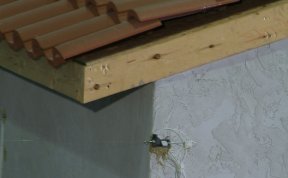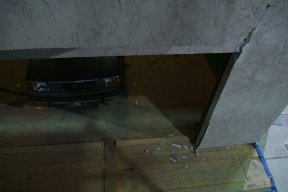Rocking the House
- 指点迷津
- 2024-11-30
- 3
In a very big earthquake, your whole house could collapse3.
To get a better idea of what might happen to an ordinary house during an earthquake, engineers did an experiment—a big one. In one corner of a building the size of an airplane hangar, they built a townhouse. Then, they shook the house with the force of a large earthquake.
| This wooden townhouse, which is similar to many homes in California, was specially built to see how it would survive the sort of shaking that it could suffer in an earthquake. |
| University at Buffalo5 |
The house, a full-scale model of an 1,800-square-foot townhouse like many found in California, is the largest wooden structure ever tested in a simulated earthquake, says Andre Filiatrault. He's a civil engineer at the State University of New York at Buffalo, where the test was conducted last November.
So, why did researchers spend several weeks building a full-size townhouse, and then try to destroy it in seconds?
First, tests of small models often don't provide accurate answers because the models are stiffer than full-size structures.
Second, the researchers wanted to see how the townhouse moved and flexed6 as it experienced the strong vibrations7.
"Scientists don't really understand how wood-frame buildings perform in an earthquake," says Filiatrault. Usually, researchers get to look at buildings only after an earthquake has knocked them down, he notes.
Finally, the researchers wanted to see what happened to furniture and other bulky items inside the home while the simulated earthquake rocked the house.
| In the dining room of the model house, the table was set, complete with dishes, silverware, and a pitcher of water. Outside the window, civil engineer Andre Filiatrault conducts a tour for a cameraman. |
| University at Buffalo |
With the help of Filiatrault's wife and children, the engineers decorated the house. They put dishes, silverware, a flower arrangement, and a pitcher of water on the dining room table. They furnished one bedroom like a college dorm room, one like a master bedroom, and one like a child's room. They even put a car in the garage.
Then, during the test, they watched the action through eight webcams that they'd placed at various points throughout the house.
Model home
The townhouse tested in Buffalo, like 90 percent of the houses and apartment buildings built in the United States, has a wooden frame. This means the skeleton inside the walls of the building is made of lumber9, usually a type of board called a two-by-four.
| This illustration shows, layer by layer, how the test house was constructed. The house rested on a concrete slab (blue). The slab was bolted to two shake tables (gray), which could move back and forth. |
| University at Buffalo |
The test home's inside walls were covered with drywall, and its outside walls were covered with large sheets of chipped wood that was glued together. The outside surfaces were coated with three layers of stucco, and then painted.
The house even had windows and sliding-glass patio12 doors.
The researchers installed hundreds of sensors13 in the home, including 75 sensors to monitor the accelerations14 caused by the shaking and 125 to measure how far various parts of the structure moved back and forth.
 |
| Sensors mounted inside and outside the home gave scientists information about how much the house moved and flexed during the simulated earthquake. |
| University at Buffalo |
The test home didn't have plumbing15 or very much electrical wiring, says John van de Lindt, a civil engineer at Colorado State University in Fort Collins. However, these items don't add much structural16 strength to a house, so the simulated earthquake test should provide accurate results, he notes.
Test quake
The model townhouse rested on a concrete slab that was bolted to two platforms called shake tables. Computer-controlled equipment moved the tables back and forth.
Before the scientists conducted the big earthquake simulation, they did dozens of small tests. They did some of the tests after the wooden skeleton was built, and others after the sheets of drywall had been attached. Yet other tests were done after the stucco had been added.
By comparing the results of these tests, engineers can figure out which individual parts of a home make it strong, van de Lindt explains.
| In this photo taken during the test, the house looks blurred because it's shaking. |
| University at Buffalo |
In the big test, the researchers simulated ground motions recorded during a magnitude-6.7 earthquake that struck Northridge, Calif., in January 1994. That quake, or temblor, killed 57 people. Sixteen of them died in a single, wood-frame apartment building. The earthquake caused about $10 billion in damage.
Despite the intense shaking during the test, the model house didn't collapse. The windows didn't even break. But furnishings were tossed about, drywall cracked, and stucco fractured. (To see webcam videos of the shaking, go to nees.buffalo.edu/projects/NEESWood/video.asp . For more details, go to www.sciencenews.org/articles/20061223/bob11.asp and nees.buffalo.edu/projects/NEESWood/ .)
 |
| Even though walls around the garage door were reinforced, the simulated earthquake caused severe damage to the walls. |
| University at Buffalo |
The researchers made several important findings. Early analyses show that drywall on the inside surfaces of outside walls adds to a house's strength. The tests also settled a long-standing debate about whether stucco can provide structural support for a building. The answer is yes, says Filiatrault.
What's next?
For the next 2 years, Filiatrault, van de Lindt, and the other members of their team will use the data they gathered during their tests to improve computer programs that engineers use to design and analyze18 wooden structures.
They'll also use information that they discovered when they disassembled the house after the tests. They know now, for example, which pieces of wood crack and where they break apart.
In 2009, the engineers will put their new computer software to the test. That's when they'll design, construct, and test a six-story wood-frame building in Japan, on the world's largest shake table.
Beyond improving design-and-analysis techniques, the test results may help engineers when they update building codes. A building code provides rules that builders must follow when putting up a house. The result could be safer houses.
"More than 100,000 people lost their lives in earthquakes in the 20th century," Filiatrault says. "Maybe this test will save some lives in the future."
President Bush Welcomes 2007 and 2008 NCAA Sports Champions to the White House
President Bush Attends Iftaar Dinner at the White House
President Bush Meets with Republican Members of the House of
八十天环游地球(AROUND THE WORLD IN 80 DAYS)-11
汤姆・索亚历险记(The Adventures of Tom Sawyer)第五章 礼拜
基督山伯爵(The Count of Monte Cristo)第二章 父与子
基督山伯爵(The Count of Monte Cristo)第三十四章 显身
本文由明日于2024-11-30发表在生活百科-红苹果乐园,如有疑问,请联系我们。
文章摘自:http://hpgly.com/post/33463.html










![[流言板]雷尔森传中,穆科科近距离射门打飞](/zb_users/upload/2024/12/3111596453046865195.gif)
发表评论